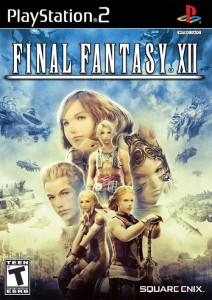Hello there, dearest Lusi-sprites. After a long, scheduling-related hiatus, I triumphantly return, bearing gifts for all the good little girls and boys. Oh, whoops, I appear to be thinking of Santa Claus, dear readers. All I have today is a review of a game that, surprisingly enough for a Deimosion review, was released within the past decade! Today’s victim is a little-known Square Enix PS2 RPG called Final Fantasy XII. Released in 2006, Final Fantasy XII was the last main-series game to be released on the PlayStation 2. While it contains many key characteristics of the series, Final Fantasy XII differs from its predecessors in some interesting ways.
Unlike most Final Fantasy games, which use a stationary turn-based or active time battle system, XII uses a battle system somewhat akin to an MMORPG. There is no transition from field exploration to combat, outside of characters preparing their weapons, and movement continues to remain free during battle. The menu-based combat of previous Final Fantasy games does make its return, though, as orders are given through menu inputs. Many compare the battles to those of Final Fantasy XI, and XII does indeed play like a refined, single-player version of the controversial MMO. Control of the three-member party is given fully to the player, who chooses a leader to move manually while the other two members follow. Commands can be manually issued to any of the party members at any time, if the player desires. Players wishing to do less part management can instead use the new “Gambit” system to automate the party’s actions.
Gambits essentially work like an “if-then” statement in programming. There are two parts to any Gambit: the targeting condition, and the action. By choosing a targeting condition like “Ally: Any” and an action such as “Haste”, the player can automate buffing, debuffing, healing, attacking, tanking, and so on. The AI is smart with its Gambits; If “Ally: Any/ Esuna” is set as a Gambit, party members will only cast Esuna on an ally afflicted with a status effect curable by the “Esuna” spell. Gambits can be prioritized, but any manually issued command will immediately overwrite a Gambit-issued automation. The Gambit system is extremely detailed, very helpful, and entirely optional, and it contributes greatly to the game’s combat. Character progression is handled both through traditional leveling and through the “License Board”, a grid-based system for unlocking the ability use weapons, armor, accessories, and abilities. Characters earn both Experience Points and License Points; both are an important part of character progression.
Like the Final Fantasy Tactics subseries and Vagrant Story, Final Fantasy XII is set in the world of Ivalice. Final Fantasy XII tells the story of a war between the nations of Archadia and Rozarria. Caught in the middle is the now-Archadian controlled nation of Dalmasca, a formerly neutral empire swept up into the war. Players take control of a young man named Vaan, a would-be pirate living on the streets of the Dalmascan capital, Rabanastre. Vaan and his friend Penelo are caught up in an adventure with the sky pirates Balthier and Fran, the former general Basch, and the Dalmascan princess Ashe. The six travel across Ivalice to stop the ambitions of the belligerent Archadian Empire. Final Fantasy XII‘s narrative is excellently written, but at times can be rather boring. The plot is heavily driven by political scheming and by the Archadian-Rozarrian war, rather than characters. As such, the character cast of Final Fantasy XII is extraordinarily bland. The six main characters are fantasy-steampunk rehashings of Star Wars characters, and leave much to be desired. The setting of Ivalice is simply marvelous, though, and Final Fantasy XII‘s world is vast. Exploration of the game’s various areas is truly Final Fantasy XII‘s strongest point; the game is an absolute delight to explore.
On a technical level, Final Fantasy XII is full of the excellent graphics and music players of the series have come to expect. Final Fantasy XII was released late in the PlayStation 2’s lifespan, and is easily among the best looking games for the system. The only complaint one could have about Final Fantasy XII‘s graphics is that the characters’ noses seem a bit odd; Vaan in particular appears to have had his nose squashed by a hammer. Still, the graphical issues are minor, and Final Fantasy XII is a wonderful-looking game. Final Fantasy XII‘s soundtrack is nothing short of amazing. The Final Fantasy XII music is an instrumental (pun semi-intended) part of the game’s experience, with the many tracks beautifully fitting the areas for which they play. The audio-visual side of Final Fantasy XII is most certainly not lacking; Final Fantasy XII both looks and sounds spectacular.
For the twenty dollars American one would spend for the Greatest Hits release of Final Fantasy XII, the game is absolutely and completely worth the price. The story alone, ignoring all sidequests, is approximately thirty to forty hours in length, but the player seeking to do everything Final Fantasy XII has to offer will spend upwards of 150 hours or more attempting to complete the games various sidequests. For JRPG fans, Final Fantasy XII is certainly worth the price of admission, and I highly recommend one who enjoys a good console RPG to seek this game out at once. What are your thoughts on Final Fantasy XII, dear readers? Have you played it, or do you know someone who has? If so, tell them to head over to Lusipurr.com and comment with their thoughts on this Square-Enix masterpiece.


